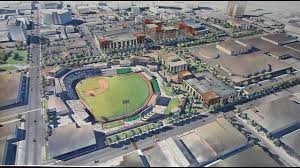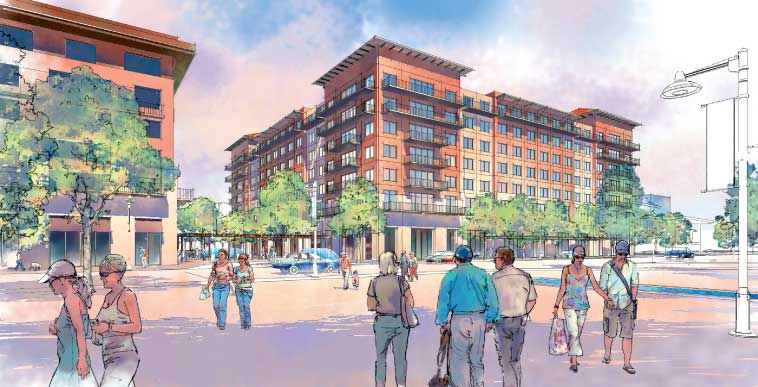Let’s take the long view, shall we?
The drawing here depicts what Amarillo’s downtown district is set to look like in about, oh, five years.
It shows a nifty little ballpark directly across the street from City Hall. To the west of the ballpark we’ll have a convention hotel. Next to City Hall there’ll be a covered parking garage.
City officials think all of this is doable. They believe that once the project is complete, the city will draw additional convention business, with flocks of convention-goers putting themselves up in lodging downtown and perhaps as well along Interstate 40.
Xcel Energy has broken ground on a new office complex it will occupy once it vacates the 31-story Chase Tower.
City and downtown development officials are planning a daylong session Wednesday to lay out the project in detail. They’ve invited the public to take part. They want to hear everyone’s concerns; they’ll certainly accept supporting comments. They also say they intend to listen to the concerns of those who are opposed — some of them adamantly — to the downtown project.
What on God’s Earth, though, can be wrong with redeveloping a downtown district that once flourished as a gathering place for Panhandle residents, but which has languished over many years as a place that remains a business and financial center, but needs some energy?
The City Council and economic development leaders have told us until they’ve run out of breath that the downtown redevelopment will occur without spending additional property tax money. They contend that hotel/motel taxes will pay for it. The money will come from those who visit Amarillo, from folks who live elsewhere.
And even that has drawn criticism.
The projects are moving forward. Agreements have been signed. They’re finally starting to bust up some pavement to make room for what promises to be a grand new look for our downtown business district.
The price tag is around $100 million. Development leaders are securing private investors to foot a huge part of the bill. Has that quieted the critics? Oh, no. They’ve persisted in the demagoguery.
I need to ask: Are we going to forsake this investment in our city’s future because some of us just cannot believe it’s possible in little ol’ Amarillo, Texas?
How about stretching our reach just a little bit to grasp what — to my eyes — looks quite promising?


